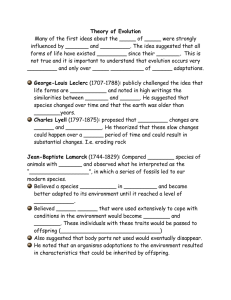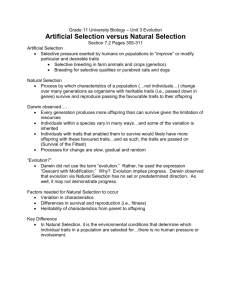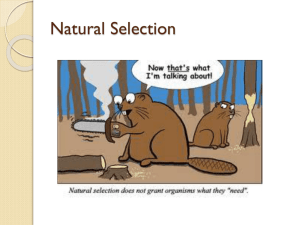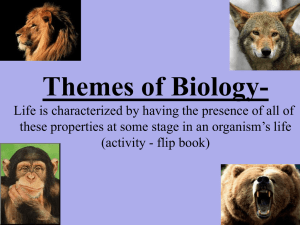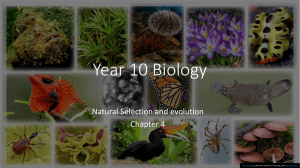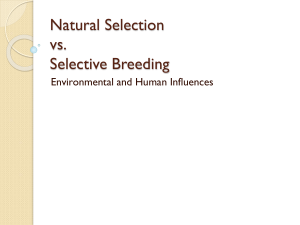Selective Breeding
advertisement
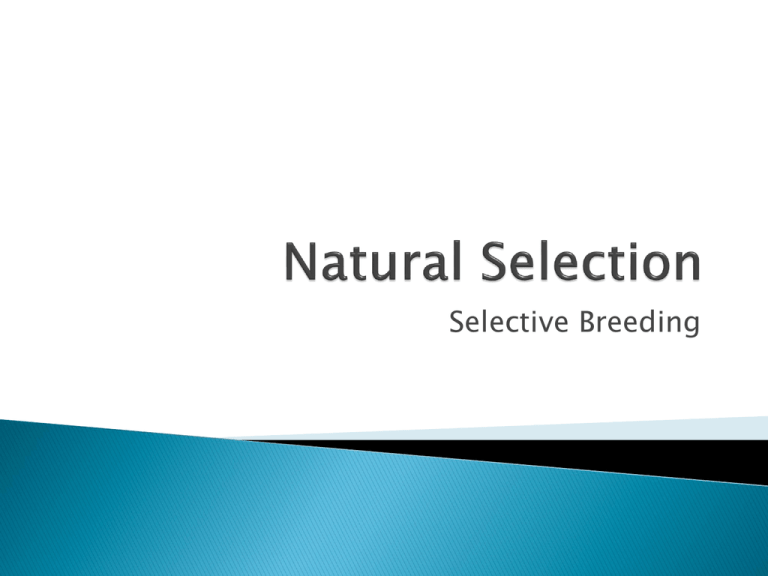
Selective Breeding Characteristics of Organisms in the Galapagos Islands compared to nearby South America Darwin hypothesized that animals came to the Galapagos from the mainland and they became different from their mainland relatives These differences are also seen among the different islands of the Galapagos Examples: Iguanas and Finches Darwin’s Observations An adaptation is a characteristic that helps an organism survive and reproduce in its environment. Adaptations include structures and behaviors for finding food, for protection, and for moving from place to place. Darwin hypothesized that species gradually changed over many generations and became better adapted to their new conditions. The gradual change of species over time is known as Evolution Selection is always from a pre-existing series or range; it creates nothing new. The very term should put people on their guard that something is missing. If we think of the word ‘selection’, in our common, daily experience, we select from something preexisting. Natural Selection ≠ Evolution. The all-wise Creator knew the different environments that His creatures would have to adapt to after the Fall and Curse, and particularly after the Flood of Noah, in order to survive. He included in the genetic information of each ‘kind’ of creature He created, a smorgasbord of variety in their makeup. This includes those features that would interact with the environment: the overall size of a plant, animal or person; the size of individual organs or limbs such as beaks and noses, leaf sizes, skin colors, hair and feather lengths, textures and colors. All of these and many more variations were programmed into the DNA of His creatures in order that as populations of the various kinds moved into new environments, expression of those variations enabled individuals to survive those environments. Individuals with those variations then passed them on to their young. When these variations and the habitat of the population expressing that variation are distinct enough, we might distinguish different ‘species’. In all of this selection process, new information is never added. It can be conserved or lost, but never gained. Job 12:7-9 7 “But ask the beasts, and they will teach you; the birds of the heavens, and they will tell you; 8 or the bushes of the earth, and they will teach you; and the fish of the sea will declare to you. 9 Who among all these does not know that the hand of the LORD has done this?” The organisms that do not have the necessary traits to survive in its environment will not live as long as those that do have the traits. So, they will not be able to reproduce as much as the organisms that live a long time. This means that more organisms with the desired traits will live from generation to generation. This process is known as natural selection. In 1791 on a farm in New England, Seth Wright notices a male lamb that was normal except for its short, bent legs. By carefully mating this lamb and its offspring, Wright formed a breed of short-legged sheep called Ancons. Man has been using genetic principles for a long time. The ancient Babylonians and Egyptians, as well as the biblical patriarchs, practiced special breeding techniques. (Example: Jacob making the agreement with his father-in-law, Laban, to keep certain cattle as his wages for tending the flocks. Jacob made a plan to keep the offspring of the stronger cattle for himself. This is an example of selective breeding.) choosing organisms with desirable traits and breeding them so the offspring will have the same traits. Selective breeding attempts to cultivate an already existing trait, not to develop a new trait. http://creation.com/ https://answersingenesis.org/ http://www.icr.org/ http://creationtoday.org/ http://www.discovercreation.org/


